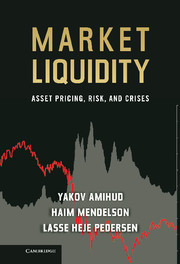Book contents
- Frontmatter
- Contents
- Acknowledgments
- Introduction and Overview of the Book
- Part I The Effect of Liquidity Costs on Securities Prices and Returns
- Chapter 1 Asset Pricing and the Bid–Ask Spread
- Chapter 2 Liquidity, Maturity, and the Yields on U.S. Treasury Securities
- Liquidity, Maturity, and the Yields on U.S. Treasury Securities*
- Chapter 3 Market Microstructure and Securities Values: Evidence from the Tel Aviv Stock Exchange
- Market Microstructure and Securities Values Evidence from the Tel Aviv Stock Exchange*
- Part II Liquidity Risk
- Part III Liquidity Crises
- References for Introductions and Summaries
- Index
- References
Liquidity, Maturity, and the Yields on U.S. Treasury Securities*
Journal of Finance 46, 1991
Published online by Cambridge University Press: 05 December 2012
- Frontmatter
- Contents
- Acknowledgments
- Introduction and Overview of the Book
- Part I The Effect of Liquidity Costs on Securities Prices and Returns
- Chapter 1 Asset Pricing and the Bid–Ask Spread
- Chapter 2 Liquidity, Maturity, and the Yields on U.S. Treasury Securities
- Liquidity, Maturity, and the Yields on U.S. Treasury Securities*
- Chapter 3 Market Microstructure and Securities Values: Evidence from the Tel Aviv Stock Exchange
- Market Microstructure and Securities Values Evidence from the Tel Aviv Stock Exchange*
- Part II Liquidity Risk
- Part III Liquidity Crises
- References for Introductions and Summaries
- Index
- References
Summary
This paper studies empirically the effects of the liquidity of capital assets on their prices. Amihud and Mendelson (1986, 1989) proposed that liquidity affects asset prices because investors require a compensation for bearing transaction costs. Transaction costs – paid whenever the asset is traded – form a sequence of cash outflows. The discounted value of this cost stream proxies for the value loss due to illiquidity, which lowers the asset's value for any given cash flow that the asset generates. As a result, the return on assets should be an increasing function of their illiquidity (other things equal). For stocks, the illiquidity effect is expected to be strong because their transaction cost sequence is infinite. Amihud and Mendelson (1986, 1989) demonstrated that common stocks with lower liquidity yielded significantly higher average returns, after controlling for risk and for other factors.
These results on the importance of liquidity in the pricing of stocks raise additional questions: (i) does the liquidity effect depend on the specific controls used by Amihud and Mendelson (1986, 1989)? (ii) does illiquidity have a similarly strong effect on the pricing of bonds, whose maturities are finite?, and (iii) if liquidity affects bond yields, how is this effect related to the bond's time to maturity?
- Type
- Chapter
- Information
- Market LiquidityAsset Pricing, Risk, and Crises, pp. 52 - 68Publisher: Cambridge University PressPrint publication year: 2012
References
- 1
- Cited by



